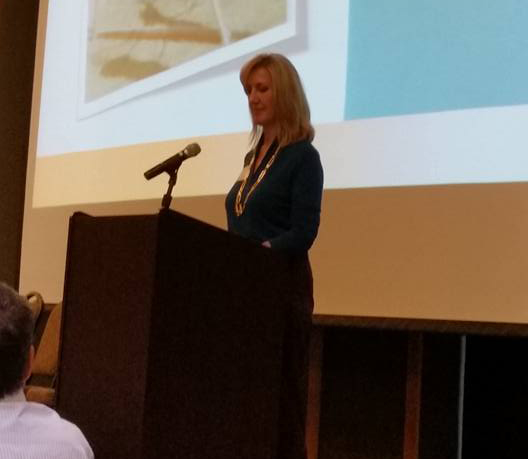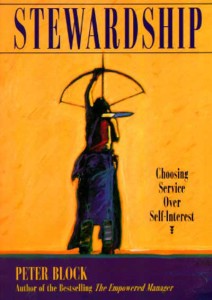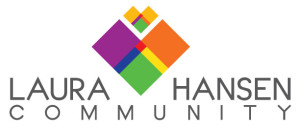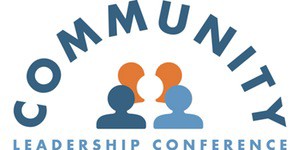Speaking on: Strategic Selflessness
The Key to Innovation, Social Change and Leadership

On September 22, 2015, Laura spoke at a leadership conference hosted by Citrus Heights’ Mayor Sue Frost and the Citrus Heights Women’s Club. For over 100 nonprofit organizations, Laura discussed the key to catalyzing mindful social change.
Below is almost the entirety of her talk (the interactive participant exercise was removed):
Laura opened her talk with this statement: “In order for positive social change to happen, for an idea to be truly innovative and for a leader to make a difference, people’s lives must be improved.”
Social change happens when a core need is met in a way that empowers and engages those adversely affected. An innovative solution identifies a core need and gives those most affected a new method or tool that empowers them and helps them engage with their communities in a positive way. When a leader consistently guides an organization to more deeply understand how to empower its constituents, innovation and social change follow. When we help each other live productive, meaningful lives, the world gets better.
Laura’s story of her first volunteer experience — “I’ve been a community volunteer since I was four years old. My grandparents signed me up to help out in their church’s ice cream booth fundraiser. The adult in the booth with me I recognized as an usher from church. He showed me the ropes. I learned how to ask, “Hello ma’am, what flavor would you like.” “Thank you. That will be 25 cents, please.”
“When we were in between customers he taught me how to count back change. It was then that I had a lucid moment – a very grown up thought: “I’m helping. I’m part of the community. I belong.” I could feel it in my whole body. I still feel it today. In that experience, a truth stuck with me — until a person activates the spirit of service within them, they may not feel they belong or are responsible for helping their community thrive.
“In my years helping people activate that volunteer spirit, to be resilient, and learn how they can meaningfully contribute, another truth has emerged as it relates to social cause organizations.
Whether you are intent on creating social change, innovating a better solution, or inspiring others to lead, the more successful you are at helping those you serve be accepted and contribute to the community, the more successful you and your organization will be.
Recommended reading, titled, Stewardship, Choosing Service over Self-Interest. It describes a solid approach to creating a thriving, on-mission organization that empowers all involved, reduces the pressure and burno ut of leadership, and keeps meaningful work front and center. This is a quote from the book on our topic today:
ut of leadership, and keeps meaningful work front and center. This is a quote from the book on our topic today:
“What is difficult about social change is to stay focused on the intimate connections between our own ability to embody our intentions both inwardly, in our own consciousness, and externally in the way we express our beliefs in our institutions.”
Peter Block, author: Stewardship, Choosing Service over Self-Interest
We can find ourselves in social cause organizations focusing on the pressing issue of how to get funding when we know we should be focusing on how we serve the mission. On the face of it, this can seem like the same thing, but it’s not. When you focus on, “How do we get funding?” you take your attention off how to serve your constituents and place it on organizational need.
When you focus on the question, “How can we serve the mission?” you look at what relationships you can build and alliances you can form. These new partnerships can join with you in securing funding for your work together. You are aligning your external actions with your inward intention.
Laura shares a success story about serving the mission — “Earlier this year, the board of WALKSacramento, an active design and walkability advocacy nonprofit agency, asked me to step in to work with the staff. Its much beloved executive director resigned for health reasons and they were looking to keep the momentum going during the search for a new ED. WALKSacramento already had an excellent reputation for their subject matter expertise, practical and aspirational recommendations on development plans, community education and for generally being fun to work with.
“When I signed on, the board asked me to do three things: 1. Empower the mostly young staff to rise to the next level of personal performance as advocates, subject matter experts and project managers. 2. Recruit an executive director who could appreciate the potential of the staff and continue moving the organization along its community leadership course, and 3. Eliminate the possibility of a funding gap that may open a up few months down the road if any grant start dates were delayed.
“I’m going to talk about #3 — the funding gap. I’m sharing this story about our funding objective because we could have focused on the question, “How do we get funding?” Which would have sent us hunting for grants or donations since those were the main funding sources. But, we didn’t. Instead, we dug into the question, “How can we best serve the mission?” We began answering that question by talking with state, county, and city departments, other community organizations, health systems, and corporations to learn about their community missions and where we might find alignment. As we did this, something remarkable happened and is still happening. By talking with these various organizations we were bringing them together around our common goals. Within the past few weeks we have all been discovering the power we have as a coalition to advance the work for safe, healthy, economically vibrant communities.
“Two weeks ago the Surgeon General announced his call to action which this year was a Call to Action for Walkability and Walkable Communities. The Surgeon General is asking all jurisdictions across the country to work together. In advance of this, WALKSacramento along with County of Sacramento (spearheaded by the indomitable spirit of Judy Robinson) formed a collaboration involving leaders in both Federal and California Health and Human Services, Department of Public Health, Kaiser, HUD, County of Sacramento, City of Sacramento and Doris Matsui’s office to launch locally this national initiative. Kaiser offered its Walk to Thrive weekly walking event on Capitol Mall as the venue since it was happening the day after the Surgeon General’s announcement. The event was great. We’re all moving forward together in conversation about further collaboration on active design and walkability.
“This story is one example among several that developed as we looked for ways to serve the mission. As a result, WALKSacramento is what my grandmother would characterize as “busier than a one-armed paper hanger.”
We’re seeing a shift in community development which puts a premium on how well an organization can share information and leverage relationships. Your organization’s ability to provide value as a collaborator in a mission-centric coalition is the new currency.
Think about your organization. Does your strategy include coalition building across all sectors in alignment to your mission and the constituents you serve?
We’ve talked about how to answer the question, “How do we serve the mission?” in way that empowers the organization to lead, be creative and collaborate, and weaves you into the fabric of community leadership.
The next step is about how to find alignment within your own organization or in a coalition. This concept can result in innovative ideas that can lead to positive social change.
In my work with volunteers and nonprofits, the most common problem is staff burnout and in turn, organizational burnout… Stay with me. It ties in.
A individual volunteer or organization can mistakenly, but with good intention, adopt a reactive mindset that the only way to ease the suffering of their constituents is to give more of themselves, more of their personal energy, more of their organizational resources. When that doesn’t work, they give more until there’s little or nothing left. In the end, they feel that they’ve failed, leaving them at a loss for how to do their life’s work. This situation illustrates a strategic mistake, not one of the heart.
Strategic Selflessness
There is an approach that fosters innovation and personal and organizational resiliency that I call, Strategic Selflessness. It’s a mindful, strategic use of staff time, expertise and resources that puts a premium on the ability of individuals to set aside their personal motivations.
Strategic Selflessness on a personal level is the person’s ability to set aside assumptions and motivations. To clearly understand the needs of the constituency and how they can be best served from their point of view.
For the organization, strategic selflessness is the ability to design processes for the greatest good of the constituents whom the mission serves, then building the organization around those processes.
If an organization’s ED and the board agree on organization’s mission, but can’t act because of differing opinions on how to execute, then your next step is to understand why the other members believe their way will work.
In these situations, the parties assume it’s their position/point of view that is correct and must be defended. And, that’s the problem. Each person has taken his or her attention off the mission and placed it on their own ideas.
Employing Strategic Selflessness is a good process to work with. You would be best served to work with a facilitator as a neutral party to support you in this process. I’d like to share the outline so you have an idea of whether this is a step that would benefit your efforts.
All parties can:
- Set aside their focus on defending their position
- In an open environment of trust, discuss with detachment why each person believes the way they do and why they hold that position
- During this process, if done well, the members will discover deeper incorrect or emotion-based assumptions and/or personal pain they’ve forgotten.
- Once these motivations are discovered and acknowledged for what they are, the team can find powerful ways forward
Why is this important for your development as a leader? If you looked at a map of all the people who dedicate their lives to serving the greater good in our region and you drew lines between all of them you would see a powerful humanitarian net crossing city and county lines. You may not know what each person’s mission is, but you would know they are working in service of it.
It’s possible you are underestimating the power you have to transform your community. What that humanitarian net doesn’t show is how organizations actually connect to each other or how easily citizens can move from one resource to another on their path to stability and ultimately the pride of contribution. Even though this network exists as mainly geographic, through service-based leadership, each organization can be a node in a network that moves people to the resources they need to rise and thrive.
The leader who seeks positive social change knows the answers are in the hearts of those adversely affected. This leader must listen with an open heart and be willing to embrace the organizational change that may be required to serve the mission.
So, be heroic. Be in the joy and hope that inspired you to live a mission-filled life. You are a leader and the community thrives when you are fully and bravely being the leader that you are.
___________________________________
If you would like to talk with Laura about what’s happening with your organization and how you can help it grow and thrive, contact us for a conversation.

